Fashion Cycle: Stages, Adoption Theory & Trend Lifespan
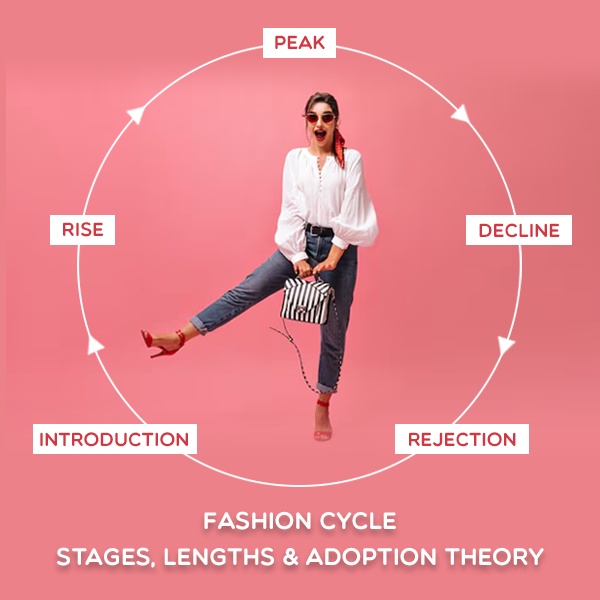
The fashion cycle is a systematic framework that tracks how
fashion trends evolve from exclusive designer launches to mass market adoption and eventual decline. This cycle helps us see that fashion is not random. Every trend follows a pattern of rise, peak and decline. Fashion students and marketers study this cycle closely. Designers use it to plan collections that feel fresh and timely. Retailers rely on it to decide what to stock and when to put items on sale. Marketing teams also follow it to promote styles at the right moment. Knowing where a trend stands in the cycle helps avoid overproduction and improves business decisions.
The digital age has made this cycle much faster. Social media, influencers and online shopping push trends to go viral overnight. A style that once stayed popular for months may now fade within weeks. Fast
fashion brands keep up with these rapid changes, while sustainable fashion tries to slow the cycle by encouraging mindful choices. Mastering fashion cycle principles enables designers to predict market demand, optimize inventory management and create commercially successful collections.
5 Stages of the Fashion Cycle
Fashion trends move in clear stages, from exclusive launches to complete phase-out. Understanding these stages helps brands, retailers and even shoppers make smart choices. Here is a simple breakdown of each stage.
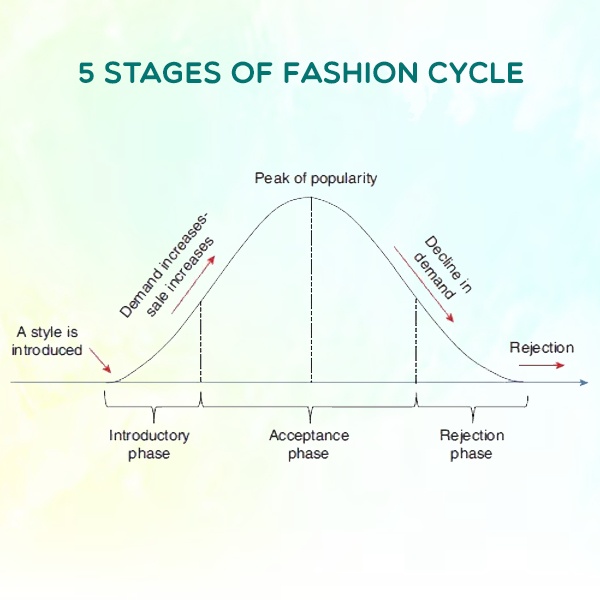
- Introduction - Designers launch a new trend on high-end runways or at exclusive fashion shows. The look feels unique and fresh, often with bold styling or unusual fabrics. Production remains limited, which keeps the prices high. Celebrities, fashion editors and select influencers are the first to wear these designs. At this point, the trend feels aspirational, not accessible.
- Rise - As the buzz grows, more influencers and stylists showcase the style, making it highly visible on social media. Popular fast-fashion brands quickly reproduce affordable versions. Retail stores start stocking similar designs and sales increase steadily. This stage marks the shift from a niche trend to one that many people want to try.
- Peak - The trend reaches maximum popularity. You can see it everywhere, from shopping malls to online platforms. Designers release variations and retailers keep shelves stocked to meet demand. Prices stabilise because of competition and the trend becomes accessible to almost everyone. This stage is short-lived, as oversaturation often follows.
- Decline - Once the market becomes crowded, interest drops. Shoppers start looking for something new. Retailers push discounts, end-of-season sales and combo offers to clear stocks. Even popular brands stop producing large quantities as the trend feels outdated.
- Rejection - The trend fades out completely. Shoppers consider it old-fashioned and brands discontinue production. While some pieces may remain in clearance racks or thrift stores, they no longer influence mainstream style. Fashion students often study such trends as part of history rather than current fashion.
Lifecycle Variations in Fashion: From FAD's to Classics
Fashion trends move at different speeds. Some disappear before you notice them, while others stay for generations. Here is a simple look at how trends shift over time and why some pieces never go out of style.
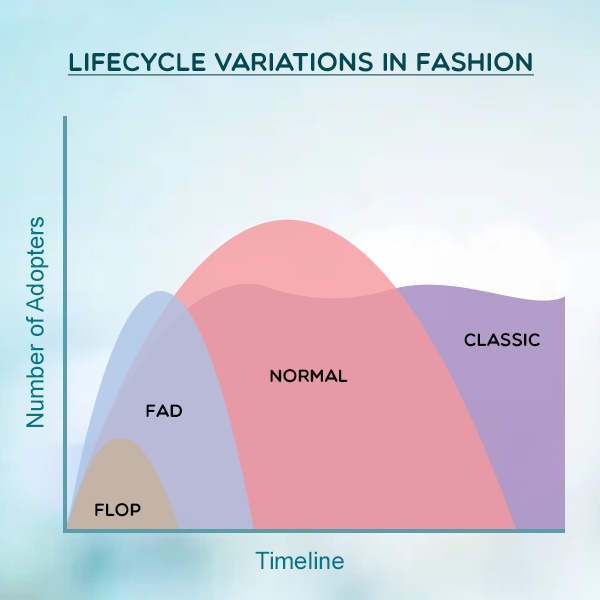
- Flop - A flop is a style that never gains acceptance. It often happens when a design does not match current tastes, cultural preferences or practical needs. These items vanish quickly from shops, leaving no mark on fashion history. Designers and brands often use these lessons to refine future collections.
- FAD - FAD's are fast-moving trends that explode in popularity but fade just as quickly. Social media and celebrity influence fuel these short-lived styles. Micro-trends are even smaller, sometimes lasting only a season. They create buzz, drive quick sales and then disappear, often replaced by the next viral look.
- Normal Trends - Most fashion items fall under normal trends, staying relevant for three to seven years. These styles are neither too extreme nor too basic. They gain popularity slowly, reach a peak and then decline over time. Brands rely on these trends for consistent sales because they allow shoppers to feel stylish without taking risks.
- Classics - Classics never go out of style. Items like denim jeans, white shirts and sarees remain popular regardless of changing fashion scenes.
- Cycles Within Cycles - Within these classics, smaller cycles emerge every 15 to 20 years, where older styles resurface with a modern twist. For example, wide-legged trousers and cropped blouses return every few decades with fresh cuts and fabrics, appealing to both nostalgic shoppers and new generations.
Case Study: The Return of Bell-bottom Jeans
Bell-bottom
jeans ruled the 1970's, vanished in the 1980's and reappeared in the early 2000's. Today, they are back again, seen on Bollywood stars and social media influencers. This revival shows how fashion cycles repeat roughly every two decades, proving that a well-loved style can always find its way back into wardrobes.
Fashion Length Cycles
Fashion length cycles show how long a particular style remains popular. Some trends last for years, while others disappear within months. These cycles help fashion brands and shoppers understand how quickly styles may change.
- Short Run Fashion - Short run fashion is all about trends that rise and fade quickly. These rapid-cycle trends emerge from cultural moments, social media virality and celebrity endorsements, typically lasting 2-6 months before being replaced by new micro-trends. Retailers produce these pieces in limited quantities because shoppers move on to new looks quickly. Short run fashion keeps the market dynamic and constantly changing.
- Long Run Fashion - Long run fashion refers to styles that stay in trend for many years. They become wardrobe staples because people find them practical, comfortable or timeless. Sarees, denim jeans and white cotton kurtas are great examples in India. These items stay in demand regardless of changing seasons. Designers often create fresh variations, but the base style remains the same. Long run fashion gives stability to the industry and helps consumers invest in clothing that lasts.
Digital Acceleration: Social Media, Fast Fashion & Forecasting
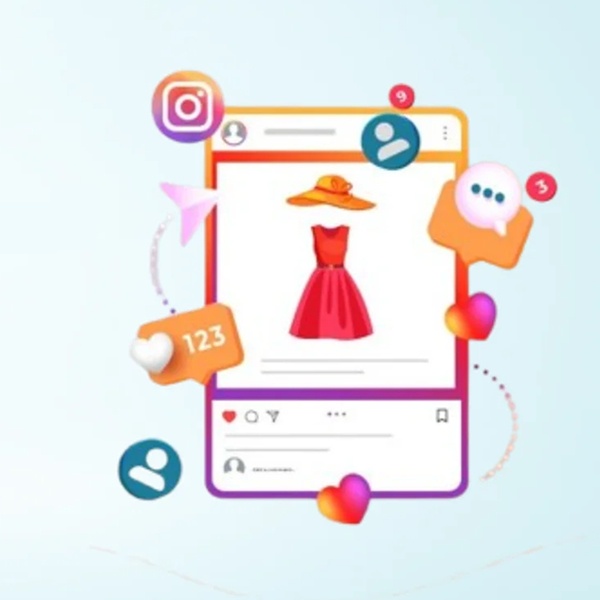
Social media has changed how quickly fashion trends rise and fall. Platforms like Instagram, TikTok and YouTube create viral moments that push a single style to millions within hours. What once took months to become popular now spreads in weeks. Influencers, reels and brand collaborations keep users scrolling, while constant exposure makes old trends feel outdated almost instantly.
Fast fashion brands like Zara, H & M and Shein use this speed to their advantage. They design, produce and stock new collections in a matter of days, sometimes even faster than forecasted demand. These brands release small batches, test customer interest and restock only what sells. This cycle encourages planned obsolescence, where clothes feel disposable because a new trend is always around the corner.
Fashion forecasting has shifted too. Instead of relying only on seasonal predictions, brands now track social media trends in real time. Data analytics, influencer activity and online searches guide what styles hit stores next. Algorithms often replace traditional forecasting teams, allowing companies to predict demand almost instantly. This speed-driven system has a cost. Rapid production increases
textile waste, water use and carbon emissions. Customers buy more but wear items fewer times before discarding them. While fast fashion thrives on this quick turnover, sustainability campaigns urge people to slow down, reuse and choose better-quality clothes. The industry faces constant tension between meeting viral demand and reducing its environmental footprint.
Digital acceleration has made fashion faster than ever, but it also highlights the need for balance. Shoppers, brands and creators play a role in deciding whether
fashion moves at this breakneck pace or slows down for a more sustainable future.
Adoption Theory in Fashion Trends
Adoption
theory explains how people accept and follow new fashion trends at different speeds. It divides consumers into five clear groups based on how quickly they embrace new styles.
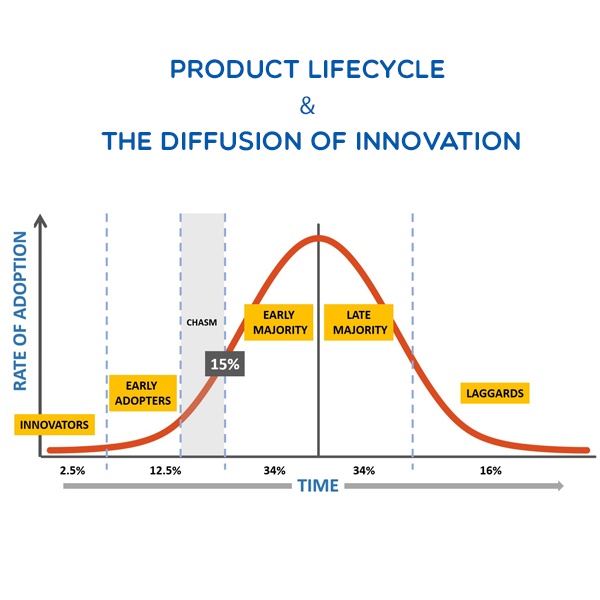
- Innovators - Innovators are the first to try a new style. They are confident, experimental and love standing out. Designers often test fresh ideas on this group because they are not afraid to take risks. Innovators make up only a small percentage of consumers but play a key role in starting trends.
- Early Adopters - Early adopters follow closely after innovators. They are style-conscious and often influence others. Many celebrities, influencers and fashion-forward shoppers fall into this category. Brands value this group because their choices set the tone for wider acceptance.
- Early Majority - The early majority waits for a trend to become more visible before buying in. They look for reliable styles that have already proven popular. This group represents a large section of the market and helps a trend move from niche to mainstream.
- Late Majority - The late majority joins once a style is everywhere. They prefer safe choices and rarely spend money on untested trends. Discounts, mass production and social acceptance often motivate them.
- Laggards - Laggards are the last to adopt a trend. They may avoid change and stick to older styles even when trends have moved on. This group is less influenced by advertising or fashion media and focuses more on practicality and cost.
Sustainability and Circular Fashion
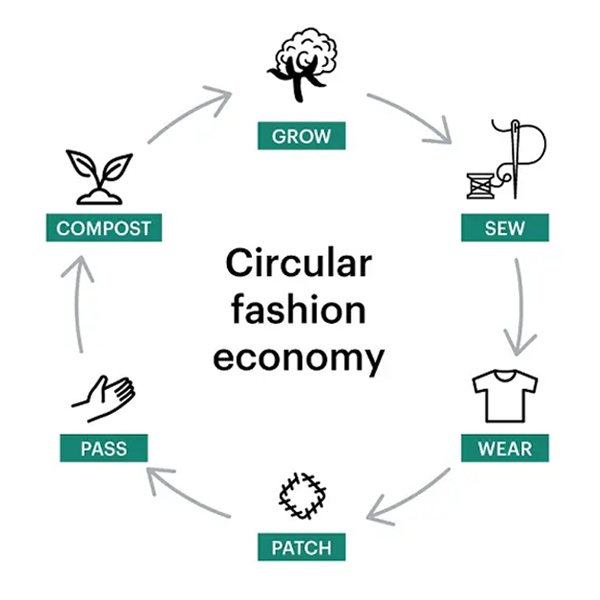
Fast fashion keeps clothes cheap and trendy, but it also creates one of the biggest waste problems in the world. Factories release harmful chemicals into water bodies and dyes often pollute rivers near textile hubs. Synthetic fabrics like polyester shed tiny microplastics every time we wash them, which end up in oceans and enter the food chain. India's growing
fashion market is no exception, with tonnes of textile waste sent to landfills every year.
Circular fashion offers a practical solution. Instead of a buy-wear-throw cycle, this approach focuses on making clothes last longer. Designers choose durable fabrics, create timeless styles and plan for garments to be repaired, reused or recycled. The second-hand clothing market alone is projected to cross 51 billion US dollars globally, with India seeing strong demand for thrift stores and resale platforms. Recycling initiatives now turn old textiles into new fabrics, reducing the need for virgin resources.
Fashion schools in India are also shifting their teaching methods. Students learn about
sustainable materials, zero-waste cutting techniques and lifecycle planning for every garment. This prepares future designers to build collections that are environmentally responsible and commercially viable. By combining thoughtful design with conscious consumer choices, circular fashion shows that style can thrive without harming the planet.
Historical Context and Theories of Recurrence in Fashion
Fashion often moves in circles rather than straight lines. Trends that seemed outdated decades ago often return with a fresh twist. This cycle is especially visible in what many call the “20-year rule”. Clothing styles and accessories popular two decades ago frequently resurface, often influenced by nostalgia. For example, bell-bottom trousers, once iconic in the 1970's, reappeared in the late 1990's and again in the 2020's, appealing to younger generations while triggering memories for older ones. The rise of industrialisation in the 19
th century played a major role in shaping these recurring cycles. With the development of textile mills,
sewing machines and rail transport, clothing became easier and cheaper to produce. Fashion shifted from being exclusive to the wealthy to something the middle class could access. This ability to mass-produce styles at speed meant trends could spread quickly, fall out of favour and later re-emerge. Over time, this industrial foundation evolved into today's fast fashion industry, where brands recycle old styles to tap into both nostalgia and novelty.
For fashion students, understanding these patterns is vital for forecasting. Recognising when old trends are ready to return helps in predicting future collections. Designers often look at archives and cultural moments from the past to create something new yet familiar. A clear grasp of these cycles gives students an edge in balancing innovation with market demand, especially in India where traditions and modern influences blend strongly.
Practical Applications of Fashion Cycle for Fashion Students
Understanding the
fashion cycle is not just theory for students; it is a practical tool that shapes every stage of design and business planning. By applying these concepts, students can predict trends, plan collections and create garments that meet consumer needs while staying relevant in the market.
- Trend Forecasting with Real Data - Students can use data analytics and social media insights to study buying patterns, seasonal demands and consumer preferences. Observing fashion shows, retail spaces and street style in Indian cities like Mumbai or Delhi gives first-hand knowledge of emerging styles. Combining numbers with observation builds a strong foundation for predicting what people will want next.
- Planning a Balanced Design Line - A well-structured collection includes a mix of basic, fashion-forward and fad pieces. This approach, inspired by Cornell's guidance for line planning, helps designers meet different market needs. Basics provide stability, fashion pieces keep collections exciting and fad items create buzz. Students can practise this mix when creating their own collections for college showcases or internships.
- Building Sustainable Designs - A sustainable design approach focuses on durability, adaptability and circularity. Students can experiment with natural fabrics like khadi or handloom cotton, which last longer and appeal to conscious buyers. Simple changes, such as designing reversible garments or easy-to-repair pieces, make collections both eco-friendly and practical.
- Capsule Collection Project - An effective way to apply these lessons is through a capsule collection project. Students can design a small range of versatile garments that reflect every stage of the fashion cycle: introduction, rise, peak, decline and obsolescence. This exercise teaches how to balance creativity with market realities, manage production timelines and plan for each piece's life span.
The fashion cycle changes fast, but core principles stay the same. Designers must blend creativity with strategy, knowing when styles rise, peak and fade. Success comes from more than design skills. Understanding markets, pricing and consumer needs is equally important. Students should study fashion history, embrace sustainability and use tech-driven forecasting to stay ahead. This mix of artistry, ethics and
business sense ensures fashion remains innovative and relevant.
FAQ about Fashion Life Cycle
1. How can a small Indian designer test a new style?
Make a few samples, show them in local markets, post on social media and take pre-orders before mass production.
2. Do pre-orders help in fashion?
Yes. They cut waste, reduce unsold stock and give buyers a sense of exclusivity.
3. Can prints or designs be protected in India?
Yes. Original prints or shapes can be registered under the Designs Act or copyright laws.
4. Do resale and rental platforms work in India?
Yes. Both are growing fast and help clothes last longer.
5. How can clothes last longer in Indian weather?
Wash less, use mild detergent, dry in shade, repair small tears and store well to avoid dampness and pests.
6. Do supply chain
issues affect fashion trends in India?
Yes. Local sourcing is faster, while imports can slow down production and raise costs.
7. How to price limited collections in India?
Keep prices higher, highlight the small run and share the story behind the product.
Yes. Use better fabrics, modern cuts and offer repair or alteration services.
9. What are simple ways to design clothes for longer use?
Make reversible outfits, add detachable parts, use leftover fabric for small items and provide repair kits.
10. How to know if a trend has peaked?
Check if online searches fall, hashtags lose reach and shops start giving more discounts.
11. Can small boutiques copy fast fashion methods?
Not fully. But they can make small runs, source locally and reorder only bestsellers.







 CONTACT USWaves Institute of Fashion Designing,
CONTACT USWaves Institute of Fashion Designing,